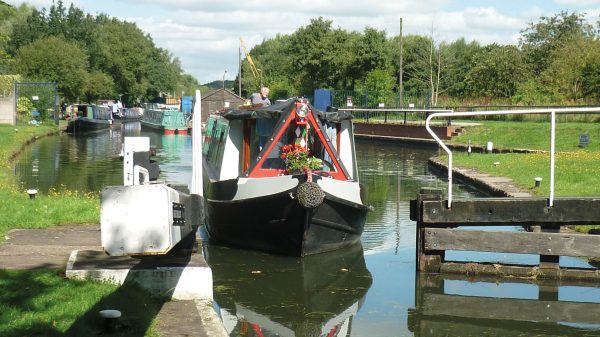From the River Trent to Langley Mill
The Erewash Canal runs from the River Trent and the Soar Navigation at Trent Lock to Langley Mill where it joins the now derelict Nottingham Canal and Cromford Canal (under restoration). The restored lock at Langley Mill, which allow entrance to Langley Mill Basin, is the first lock on the Cromford Canal.
The Derby Canal (under restoration) joined the Erewash Canal at Sandiacre Junction (just above Sandiacre Lock). The Nutbrook Canal (derelict and filled in) joined the Erewash Canal just below Hallam Fields Lock.
This canal was built to carry coal from the Erewash Valley. It was bought by the Grand Union in 1932 but fell into disuse after the war.
History
The Erewash Canal runs for nearly 12 miles between the River Trent, near Long Eaton, and Langley Mill, and for the most part it follows the River Erewash, which forms the boundary between Nottinghamshire and Derbyshire. The canal finally crosses the river as it moves into Nottinghamshire at the three-arched Shipley Aqueduct which, apart from locks, is the only major structure on the canal. This wide canal with 14 locks was surveyed by John Smith and designed by John Varley, received Parliamentary approval in 1777 and by 1779 it had been constructed at cost of £21,000; £2,000 under budget and ahead of time as well.
The canal was built largely to bring coal out of the Erewash Valley pits and down to the River Trent for onward trade to Nottingham and Leicester; it was profitable with £100 shares selling at £1300 and a maximum dividend of 78%. It initially served the many ‘bell’ pits between Ilkeston and Langley Mill, with horse-tramways bringing coal to waterside wharves at several points that are now rural areas. From Ilkeston downwards, there were major iron works at Cotmanhay, Stanton and Trent Lock. Smelting continued at Stanton until the 1970s but iron pipes are still made and token loads were carried by narrow boat for the Devizes back-pumping scheme in 1995.
Coal owners were the original proprietors of the canal and Robert Barber and Thomas Walker who later formed the Barber Walker Colliery Company were commissionaires of the canal, sorting out problems and arguments with the various boat owners. They were also proprietors of the Cromford and Nottingham Canals, which joined the top end of the Erewash Canal in 1794. Others were Benjamin Outram and William Jessop, who formed the Butterley Company and had extensive iron and coal interests further up the valley.
The Erewash, unlike the Cromford and Nottingham canals, was never taken over by the railways and remained profitable and independent until absorbed into the Grand Union in the 1930s. Coal mining subsidence, which closed the Cromford and Nottingham Canals, did not affect the Erewash Canal so badly. Some lock walls were raised and the surviving original brick arch bridges on lock tails make passage difficult for boats over ten feet wide.


